First day cover – Kenya mushrooms

The mushroom stamp series – Dvora Bochman 1989

In 1989, the Ministry of Communications in Nairobi, Kenya published the Stamps Edition: Edible Mushrooms. These five commemorative stamps constitute the first series designed by Dvora Bochman.
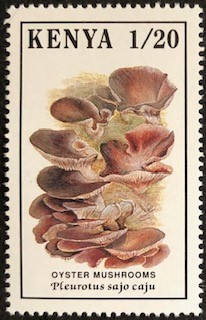
Oyster Mushroom (Pleurotus ostreatus) 1/20 KSH
In Hebrew: the shell mushroom, the forest mushroom, Pleurotus. Its scientific and popular name refers to the fruit’s upper part and its cap’s shape. The mushroom resembles an oyster with a 2.5-5 cm diameter (aquatic mollusks with the same name), hence its nickname, “mussel mushroom.”
Mushrooms of this variety are common almost all over the world. In nature, it grows on the ground and feeds on small worms and feeds on rotten trees on which it will grow. It was first studied in 1775 by a Dutch scientist named Freiherr von Jacquin.
The interest in this mushroom arose due to the speed with which it grows in a civilized way and its ease of cultivation on farms – at a warm temperature and neutral humidity. Its taste is spicy, sweet, sour, nutty. Its nutritional value is rich and serves as a quality substitute for animal protein. It also has diverse medicinal values. All its parts: the mycelium, the fruiting body, and the spores – are edible.
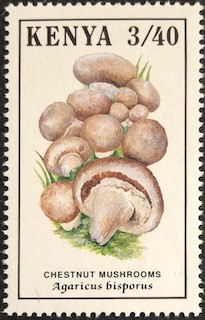
Chestnut Mushroom (Agaricus Bisporus) 3/40 KSH
It was introduced in Kenya for the first time by the Eldore Ltd. company as one of the four varieties of mushrooms that it grew and marketed for the first time in Kenya.
In Hebrew: champignon, portobello, or portobella (two-spored mushroom), the mushroom is edible. Grown after rain naturally in Europe and North America in fields and even near urban environments, as well as commercially in over 70 countries. One of the most consumed mushrooms in the world and is an important source of many minerals and vitamins. They are low in calories and contain mostly water.
Its color is brown, and it was first described by the English botanist Mordechai Cubitt Cook in a book on mushrooms from 1871.
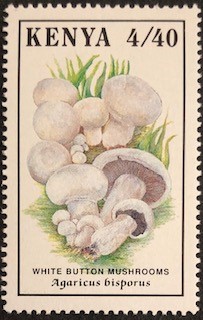
White Button Mushroom (Agaricus Bisporus) 4/40 SHS
In Hebrew, the white mushroom is known as champignon. It is one of the most widely consumed mushrooms in the world. In 100 grams of fresh white champignon mushrooms, you can find group B vitamins – riboflavin, niacin, and pantothenic acid (about 19% of the recommended daily intake).
The white mushroom was discovered in 1925. It grew in a bed of brown mushrooms at the Keystone Mushroom Farm in Coatesville, Pennsylvania. Louis Ferdinand Lambert, the owner of the farm and a microbiologist by training, developed the white variety in his laboratory. The white mushroom was seen as an attractive product and was distributed worldwide.
In modern farms in Israel, growing the mushroom is considered high-tech agriculture that does not require land and water but appropriate equipment and knowledge. The farms have a very large production capacity due to the advanced breeding methods. To grow mushrooms, special buildings are built in which the mushrooms are grown in multi-story compost surfaces. The buildings are equipped with control units that maintain optimal growing conditions: humidity, ventilation and temperature.
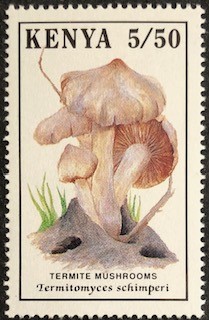
Termite Mushroom (Termitomyces schimpri) 5/50 SHS
A seasonal edible mushroom that excels in its yellowish to reddish-brown color. It appears mainly between January and March during the main rainy season and exists in symbiosis with the termites and is completely dependent on them to survive. The fungus grows on ‘combs’ that are formed from their secretions and grows quickly to a diameter of 15 to 40 cm. It excels in a large root species about 90 cm long (pseudorrhiza) and emerges from the soil of the mound.
The fungus may re-emerge on the termite mound for many years even when it is harvested for eating if the root consumed by termites remains in the soil. However, the spores are mainly transferred as a result of their dropping from the fungi, which protrude from the termite mound.
The habitat of the fungus is in the northern part of South Africa, from northern Namibia to the Congo, and in the east to Malawi and Mozambique. There are 30-40 species in this genus.
Previous scientific texts have not been able to adequately prove the symbiotic relationship between these termites and fungi, but from 1955 to 1969 Arthur Franz worked in Uganda (as a hobby) on fungi and termites. He conducted a study with the help of elderly people collecting termite mushrooms, and published his findings.
There is difficulty in cultivating the mushrooms. They are harvested directly from termite nests. Therefore, to prepare the traditional food you will be required to pay a high price.

Shiitake Mushroom (Lentinus edobes) 7/70 SHS
Shiitake is an edible mushroom. This type is the second in global consumption. In nature, it grows in the forests of East Asia, in a hot and humid climate, and especially next to deciduous trees in a state of decay such as: mulberry, oak, poplar, beech, chestnut…
The earliest records of shiitake culture are found in records prepared by He Zan in 1209 during the Han Dynasty in China. From China the technology goes to Japan. In 1796, the first book on growing shiitake mushrooms by the Japanese gardener Sato Churio was published, he described the culture of the mushroom by cutting down a shea tree with axes, and placing logs on top of those that already grew shiitake or that contained spores.
A 1982 report on the germination of the Japanese strain opened an opportunity for commercial cultivation in the United States. Today shiitake is grown commercially around the world. The mushrooms usually grow in conditions similar to their natural environment on an artificial substrate or on oak logs.
Shiitake mushrooms are nutritious, rich in proteins and contain nine essential amino acids. They are considered medicinal mushrooms in traditional medicine, and today their effect on curing a variety of cancer diseases is being studied.
Technical details – Kenya mushroom stamps
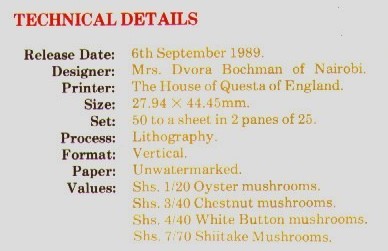
As mentioned, the mushroom series was the first that the artist performed. It was a production that accompanied the penetration process of the mushroom growing industry in farms for marketing in Kenya. The appeal to her happened because the artist who handled this series was disqualified. At the time when the work was done there were no internet services and the information about each mushroom was collected personally by the artist. Thus she joined the pilot of an air delivery to one of the farms in the city of Eldoret and during the flight experienced a traumatic experience that she will not forget. There she photographed the different varieties in the giant sacks in which they were grown. She talked with the growers and at the end of the various meetings and correspondence she realized that the message was twofold.
Dvora had to make drawings, but the stamps also had to serve as an informative model and convey clear images of the mushrooms. The paintings were done in a naturalistic style without various colored additions that characterized monochromatic or low-color themes in period stamps. The handling of the sparsely colored edible mushrooms that were grouped into a kind of family model paid respect to their shape and color, each stamp also referred to the other stamps in the series, and together they created a delicate composition of edible mushrooms. The fourth stamp, which is also suitable for human consumption, grows in the wild on the dirt wires used by the termites.

When the series was drawn, the mushrooms of this type were not in nature because it is a seasonal mushroom. Therefore the previous artist failed in his painting. He drew a mushroom that randomly grew on the termite mound. Armed with this information, the artist turned to the National Museum in Nairobi and asked to see a photograph or drawing of this mushroom. What she received was a dried mushroom similar to the dried mushrooms we buy for eating. This fungus has a long root with the help of which the symbiosis between it and termites is carried out.
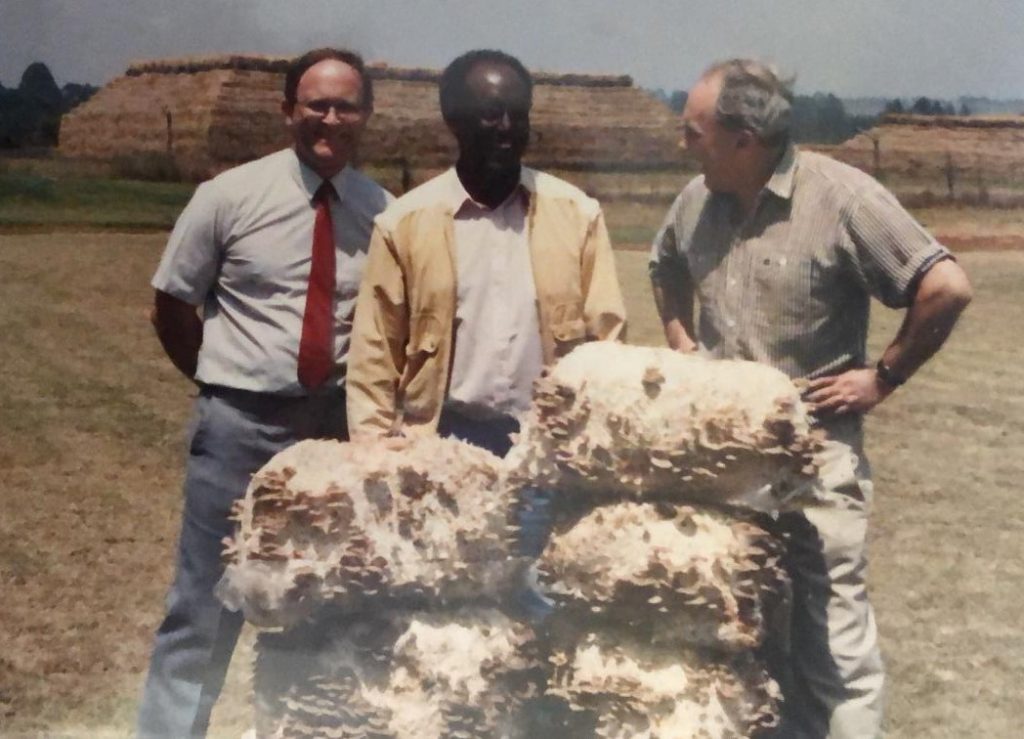
The artist used her imagination and created the stamp with the characteristic root drawn out of the ground as it confirms the variety. After the delivery of the series she met a man who came to Nairobi in those days and had a huge collection of mushroom photographs. When she looked at the photo, she was happy that the product of imagination matched the one taken in reality. On another occasion, she was offered to taste a delicacy made of mushrooms straight from termite nests. On that occasion she also saw the mushrooms as they grow in nature.
On her favorite train trips to Mombasa, when the train passed over dirt wires, she used to call out to her children through the car window: “Look at the termitomyces” she happily exclaimed!


